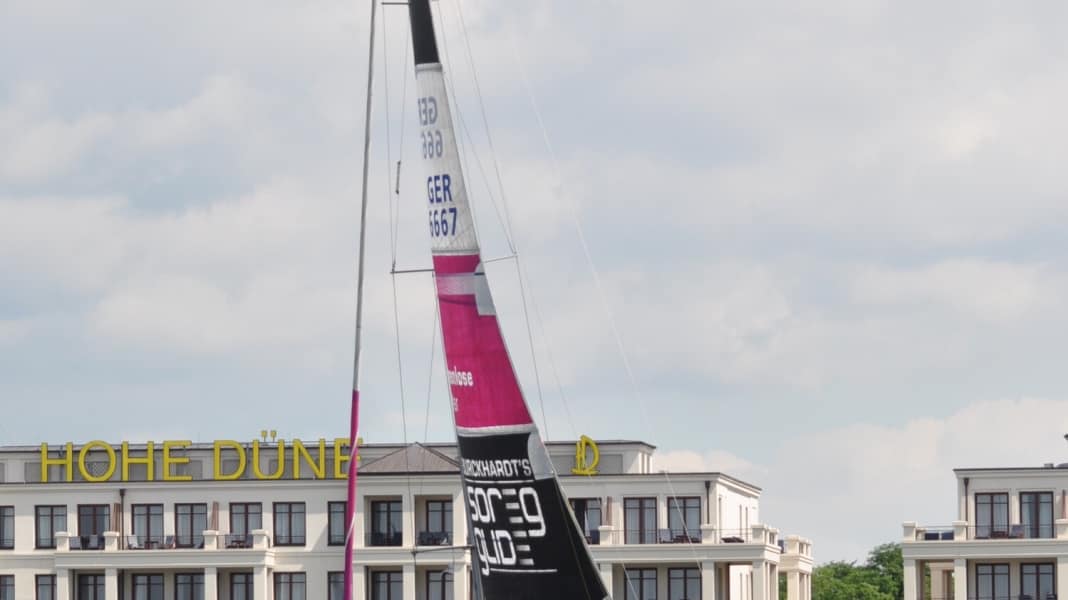
The "Kallisto" is a 50-foot performance cruiser with 130 to 200 square metres of sail area. She was built four years ago by the Saxony-based shipyard Race2Win and has been chartered out for incentives by her new owners, Torsten and Andrea Michelmann, since this season. Torsten Michelmann was taking part in the Rund Bornholm long-distance regatta at Warnemünde Week with a crew when his yacht sank north of Bornholm. He tells YACHT online about the sinking.

Mr Michelmann, please tell us what happened.
There were nine of us on board, four people with skipper experience, the rest friends of mine. On the way to Bornholm we had about 15 to 18 knots of wind, not much more, and sailed under gennaker. Strangely enough, some yachts north of Darßer Ort got caught in a storm and suffered damage, but we avoided it completely. We sailed up to Klintholm, jibed and then sailed down to the southern tip of Bornholm with a beam reach. There was never any situation with too much wind or anything like that. Everyone just had a grin on their face.
So the conditions weren't tough?
On the east side of Bornholm we were even able to sail with a gennaker until the centre due to a wind shift, but then we had to go upwind. Up to the northern tip of Bornholm, Hammerodde, we only had about 20 knots of wind, but then we reefed the main once as a precaution because one of my fellow sailors, who has sailed around Bornholm several times, said that it often blows stronger at this corner due to a chop effect and we didn't want to overtax the inexperienced sailors on board.
So the wind picked up?
There was more wind, about 25 to 26 knots, more waves, about three metres. But these are not tough conditions for a 50-foot racing yacht. Five nautical miles from Bornholm, there was suddenly a strange sideways movement, like a jerk, but somehow spongy, not like when you hit a sandbank, where you are really slowed down. It must have been quite violent below deck though, there must have been a loud thud. A crew member was asleep and didn't realise what was happening to him.
Where were you?
I was at the helm and two others were in the cockpit with me. I didn't think much at first, just: What was that? One of my fellow sailors also noticed and asked what it was.
Do you know more now?
Not really. We thought we saw a shadow in the outgoing wave, perhaps a tree trunk or a barrel, but we're not sure.
Has there been a change to the boat?
The steering was suddenly a bit wobbly, whereas before the boat had been sitting perfectly on the rudder. I thought maybe a steering cable had broken. My co-sailor said he would have a look at it and then said: "You don't want to know."
What damage have you detected?
The rudder coker was torn out of the hull in a circle at the bottom. A hole about 30 centimetres in size gaped open again and again in the wave movements, levered open by the rudder, which was still attached and was getting bigger and bigger due to the constant back and forth. The water just shot in there.
Why didn't you seal the leak?
We couldn't get close, the quadrant covered the damaged area, so we couldn't get a cushion or a fender between them. In addition, the whole rudder was constantly swinging from left to right, a huge piece of metal. If someone had gone in there, they would have broken all their arms and legs.
Have you done anything else?
We switched on all the pumps, got the other six out of their bunks and put life jackets on them. Then we formed a chain of buckets and cleaned like mad. After half an hour, the water was already a metre high.
That must not have been a good feeling.
Not from the start. As soon as I saw the hole and the water pouring in, I sent a crew member down and he made an emergency call. We also shot red twice. I don't think we have anything to criticise from a seamanship point of view. It all happened very calmly, nobody said afterwards that they felt their life was in danger at any time.
When did you give up the yacht?
The water was knee-high in the cockpit, and when the first big waves came through into the companionway, we looked at each other and said: "Right, now clear the life rafts and get out." We didn't want the ship to sink under our feet. We had also been waiting for the rescue cruiser. It was supposed to be there in 40 minutes, but when it wasn't there after 50 minutes, we had to do something.
Nine of you are travelling to the island?
No, we had two with us. Because the ship was also operated commercially, it was approved by the See-Berufsgenossenschaft, and two islands were mandatory with a maximum crew of ten. We also had all the other safety equipment on board, such as sufficient life jackets and Epirb.
A ferry was already at the scene of the accident, and the race participant "All4One" was quickly on the scene and nearby. Why was she not recovered from this yacht?
That wasn't possible in three metres of swell, they would have smashed the boat. What's more, the rescue cruiser turned up just as we were unhooking the second island.
What goes on in your head when you see your own ship sinking?
I haven't really realised it yet. Of course I was shocked, the shock is still deep, but one of my first thoughts was that luckily nobody was hurt. But it was a dream boat, it sailed like a dream and put a grin on the faces of everyone who sailed on it. What's more, the business model worked very well. It was a dream come true.
What happens next? Was the yacht insured, will it be salvaged?
The ship was fully insured with everything that is conceivable around it, so I'm not worried for the time being. It's lying at a depth of around 50 metres, not in a fairway. I don't yet know whether it will be salvaged.

